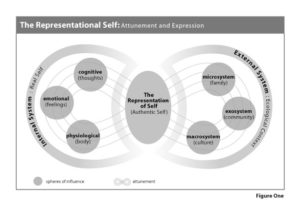
I was thrilled when the Academy announced this year’s National Nutrition Month theme. To me, “Eat Your Way, Every Day” exemplifies how RDs differ from all of the other health and nutrition coaches out there.
In my last StoneSoup blog post, I described some solutions for RDs when a client asks for a diet or quick fix to follow. I find this year’s NNM’s theme so compelling because it’s all about assisting clients in making lifestyle changes that will be sustainable and right for them for the rest of their lives!
I’d like to share with you a tool I use to help my clients discover a healthful, satisfying pattern of eating. This diagram, developed by Dr. Catherine Cooke-Cottone, a researcher and licensed therapist, is a great counseling tool to help clients learn to eat their way, every day.

The goal of this exercise is attunement, defined as “to bring into harmony with.” Each component affects eating patterns, and when all of the elements in the diagram are working harmoniously, our health and well-being are supported.
Let’s break the picture down together. First, it compromises two systems — one internal and one external. Each system contains three parts. The internal system is “thoughts,” “feelings” and “bodily processes.” The external system is “family,” “community” and “culture.” Examining each component in detail is a great technique to help your clients identify the root of what sets them up for unhealthy eating patterns. I’d like to share with you some examples to show you what I mean.
Internal System
Thoughts influence both our feelings and behaviors, as explained by the field of Cognitive Behavioral Therapy. Often, clients experience self-sabotaging thoughts that get in the way of their success. Invite your clients to notice their food-related thoughts and help them re-frame them in a way that sets them up for success. Common pitfalls include:
- “I overate at lunch. This day is ruined, I’ll start over tomorrow.”
Reframe: “Well, I overdid it at lunch. I’ll likely stay fuller for a longer period of time this afternoon. I’ll wait until I feel hungry and then get back on track with my eating plan.” - “Healthy eating is unsatisfying, I just can’t do it.”
Reframe: “There are several foods I really like that are naturally nutritious. I’ll talk with my RD about how to balance my food choices so I’m satisfied and taking care of my health.” - “I can’t believe I ate that hamburger. I’m so ashamed, I’m so disgusting.”
Reframe: “Eating a hamburger doesn’t make me a disgusting person. I can be thoughtful about my food choices at other meals so I can balance out my food choices and incorporate the other food groups.”
All of us experience a wide range of emotions every day. You may want to ask your clients which emotions are the hardest for them to tolerate and what coping skills they have in place. You can also inquire if your client finds himself or herself eating when not hungry and investigate when this happens most frequently. If it seems like certain emotions play a role in unhealthy eating, you may want to suggest this person work with a counselor to help them develop other ways to cope with challenging emotions.
As humans we are neurologically wired to pay more attention to our thoughts than body processes like hunger, fullness and satiety. One of the most important things you can teach your clients is how to accurately listen to cues from the body and problem-solve barriers to responding to those cues. I highly recommend you check out the Center for Mindful Eating for free resources that will help you develop your skill set in this area.
External System
As dietitians, we know how much conflicting nutrition advice our clients receive from family, community and cultural influences. We are well-equipped to help our clients sift through the maze of confusing nutrition messages. Below are a couple of ideas that may help you in your work.
- Use this free resource from the Center for Media Literacy to teach your clients how to critically analyze health and nutrition messages.
- Visit the Academy’s Evidence Analysis Library and News Center. Did you know members can have daily and weekly summaries of the newest research and headlines delivered to your inbox for free?
- Ask your clients to consider taking a break from certain media outlets as they work with you to develop an eating plan that works for them. Decreasing unhelpful external influences while increasing the amount of attention paid to internal resources can help our clients reach a healthier balance to their life.
Happy National Nutrition Month!
Diagram used with permission: Cook-Cottone, C. P. (2006). The attuned representation model for the primary prevention of eating disorders: An overview for school psychologists. Psychology in the Schools, 43, 223-230.







